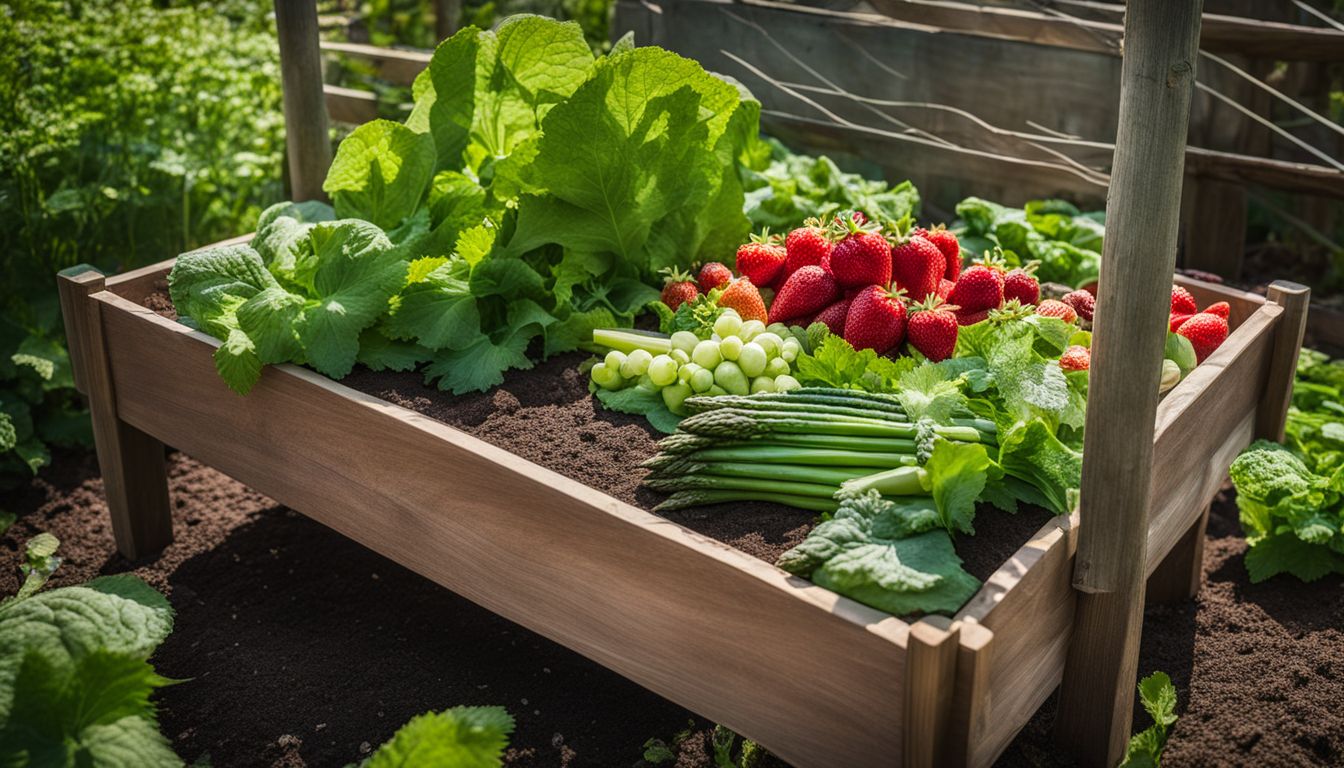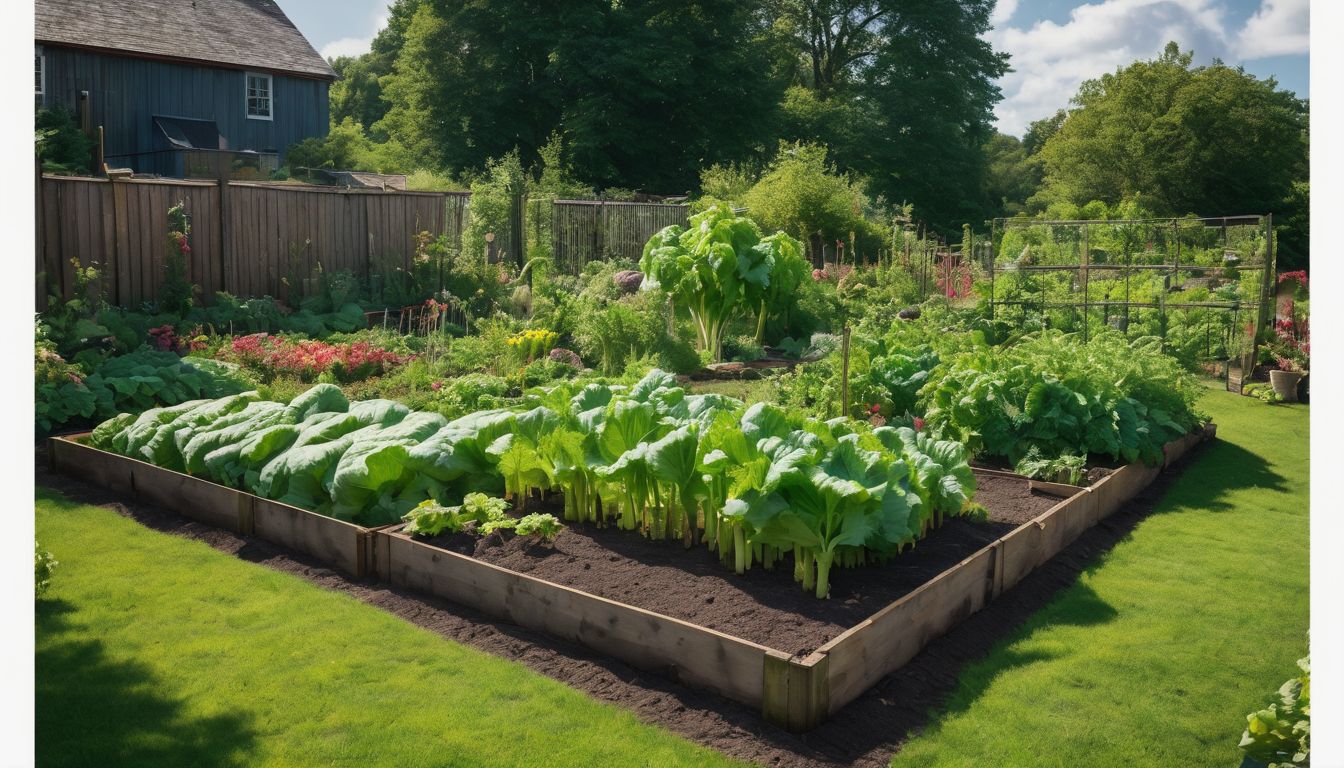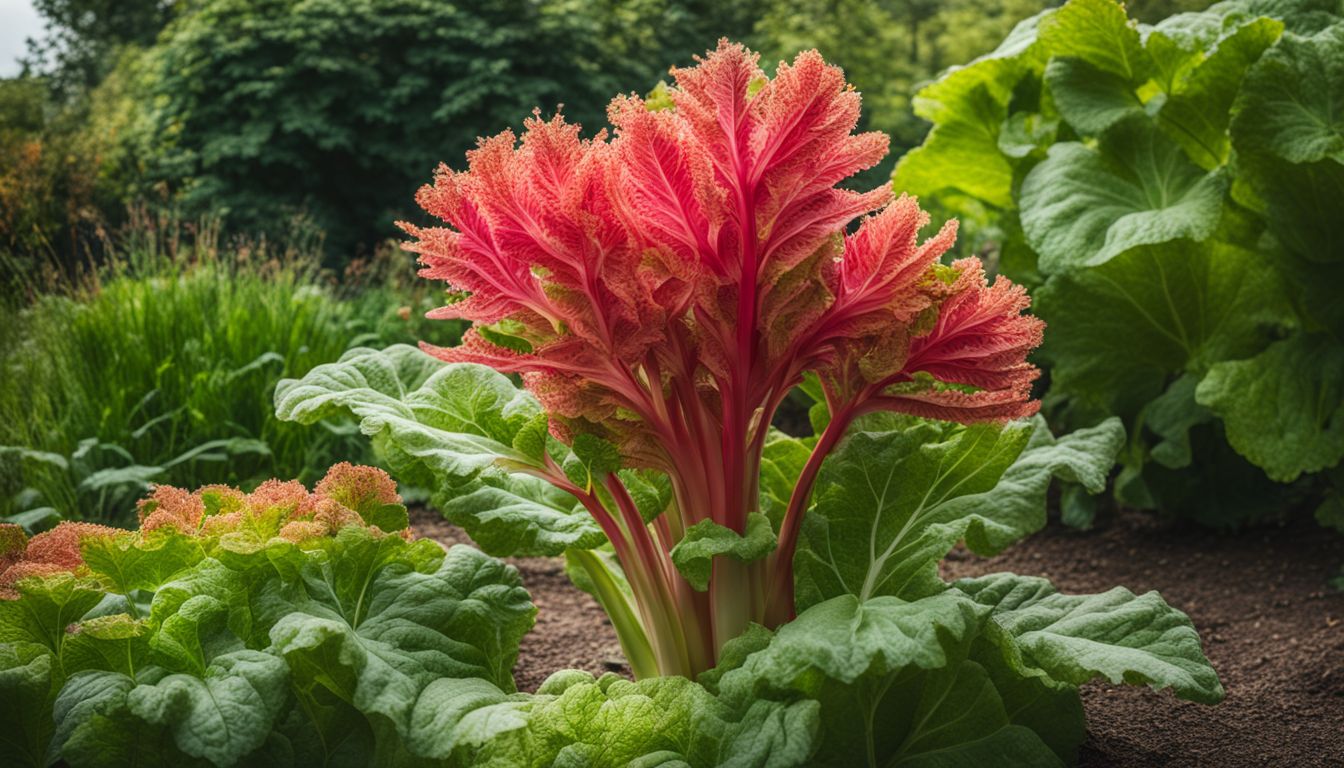Gardeners often wonder which plants thrive together in their vegetable patches. Rhubarb, with its towering leaves and tangy stalks, can play a key role in your garden’s ecosystem. Our guide dives into the ins and outs of Companion Plants For Rhubarb, highlighting partnerships that boost growth and deter pests. Keep reading to transform your garden into a flourishing community of mutually supportive plants!
Key Takeaways
- Partner rhubarb with strawberries, beans, garlic, herbs, cucumbers, and asparagus for a healthier garden. These plants support each other by fixing nitrogen in the soil or reducing pests through natural deterrents.
- Avoid planting rhubarb near potatoes, tomatoes, and members of the Brassica family like broccoli and cabbage because they compete for nutrients or attract harmful pests and diseases.
- Use proper spacing between companion plants to give them room to grow without competing. For example, leave at least 18 inches from rhubarb to strawberries and 3 feet between individual rhubarb plants.
- Rhubarb works well as living mulch due to its large leaves shading the ground, which helps retain moisture in the soil while suppressing weed growth.
- Keep deer-resistant plants in mind when companion planting with rhubarb. Selecting such plants can help deter deer and minimize pest damage in your garden.
What is Companion Planting?
Companion planting is the practice of growing different plants together in a way that benefits one or both of the plants. It can help with pest control, pollination, and even improve soil health.
There are several popular companion plants that work well with rhubarb to enhance its growth and yield.
Benefits of companion planting
Companion planting taps into the natural relationships between plants. This approach creates a harmonious vegetable garden where plants support each other’s growth.
- Deterrence of Pests: Certain plants, when placed near rhubarb, emit scents or chemicals that repel harmful insects. For instance, the strong smell of garlic can discourage pesky aphids from settling on nearby leaves.
- Attraction of Beneficial Insects: Flowers from herbs and strawberries planted with rhubarb lure pollinators and predatory insects. These allies help to keep pest populations in check and assist in the pollination process for healthier, more abundant crops.
- Improved Soil Health: Legumes like beans enrich the topsoil by fixing nitrogen, a vital nutrient that supports rhubarb growth. Rhubarb also benefits from better soil structure due to its companions’ root systems breaking up dense earth.
- Natural Mulching: The broad leaves of rhubarb serve as a living mulch, shading the ground and retaining moisture. This reduces water evaporation and keeps weeds at bay while protecting companion crops’ roots from extreme temperatures.
- Enhanced Growth for Shade-Loving Plants: Companion crops like strawberries thrive under the partial shade provided by giant rhubarb leaves. They form a ground cover that further suppresses weeds and creates an efficient use of space in potager gardens.
- Maximized Garden Space: With careful placement and spacing, companion planting maximizes productivity within limited spaces. A diverse array of vegetables benefits from each other’s presence without competing for resources.
- Decreased Need for Chemicals: By attracting beneficial insects and improving soil health naturally, gardeners find less need for synthetic pesticides and fertilizers. This leads to a more eco-friendly vegetable garden with a balanced ecosystem.
Popular companion plants for rhubarb
Choosing the right partners for your rhubarb can lead to a healthier, more productive garden. Companion planting pairs up different plants to benefit one another, often resulting in better growth and pest deterrence.
- Strawberries: These juicy fruits make great neighbors for rhubarb. They thrive in the dappled shade provided by the larger rhubarb leaves and offer a living mulch that helps retain soil moisture and suppress weeds.
- Beans: This versatile group of plants fixes nitrogen in the soil, enriching it for nutrient-hungry rhubarb. In return, rhubarb’s large leaves can help shade bean plants on scorching summer days.
- Garlic: Known for its strong scent, garlic is a powerhouse when it comes to repelling pests like aphids and whiteflies that could harm adjacent crops. Planting garlic near your rhubarb can serve as a natural insect deterrent.
- Herbs: Many aromatic herbs, such as oregano and sage, not only enhance flavor in the kitchen but also repel various pests with their strong scents. Certain herbs may ward off coleoptera and other insects from feasting on young rhubarb stalks.
- Cucumbers: The sprawling nature of cucumber vines can benefit from the structural support of sturdy rhubarb stems. Plus, this arrangement maximizes space usage in your vegetable gardens.
- Asparagus: Both asparagus and rhubarb are perennial plants that wake up early in spring. Planting these together aligns their growing cycles and makes planning your garden easier each year.
Best Companion Plants for Rhubarb

– When it comes to planting companions for rhubarb, consider adding strawberries, beans and garlic, herbs, cucumbers, and asparagus to your garden. These plants can benefit from each other’s proximity and create a healthier growing environment overall.
Strawberries
Strawberries make great companions for rhubarb because they thrive in similar conditions. Both plants flourish in acidic soil, which means they can happily share a garden bed without one outcompeting the other.
People often plant strawberries around their rhubarb to take advantage of this compatibility.
Having strawberries as neighbors benefits rhubarb by acting like natural mulch. They spread across the ground, creating shade that helps keep weeds at bay while maintaining moist soil conditions.
In turn, the tall stalks of rhubarb provide a canopy that protects sensitive strawberry leaves from harsh afternoon sun, reducing water loss and heat stress on these juicy fruits. This thoughtful pairing allows gardeners to maximize their space with two crops that not only grow well together but enhance each other’s living environment.
Beans and Garlic
Beans and garlic are excellent companion plants for rhubarb. Garlic is known for its pest-repelling properties, helping to deter pests that may harm rhubarb.
Additionally, beans have the ability to fix nitrogen in the soil, which can benefit the rhubarb by providing it with the necessary nutrients. Planting beans and garlic near rhubarb can create a mutually beneficial environment where each plant supports the growth of the others.
When interplanted with rhubarb, beans provide nitrogen through their root nodules while garlic acts as a natural pest deterrent. This symbiotic relationship benefits all three plants and promotes healthier growth overall.
Herbs
Companion planting herbs with rhubarb can offer numerous benefits. Herbs like chives, dill, and chamomile not only enhance the flavor of rhubarb when grown nearby but also attract beneficial insects that aid in pollination and pest control.
Furthermore, certain herbs such as garlic and basil possess natural pest-deterring properties that help protect rhubarb from unwanted invaders. These symbiotic relationships between herbs and rhubarb promote a healthier garden ecosystem while enriching the soil with essential nutrients for sustained plant growth.
By incorporating various herbs into your garden alongside rhubarb, you can create a harmonious environment that fosters robust plant growth and enhances the biodiversity of your space.
Cucumbers

When it comes to finding the ideal companion plants for rhubarb, cucumbers are a top choice due to their symbiotic relationship. Cucumbers offer several benefits as companions to rhubarb.
They attract beneficial insects such as bees and predatory wasps that help in pollination and pest control, contributing to a healthier garden ecosystem. Additionally, cucumbers have shallow roots that don’t compete with the deeper roots of rhubarb, making them an excellent complement in terms of nutrient uptake from the soil.
Moreover, cucumbers provide ground cover around the base of rhubarb, helping retain moisture and prevent weed growth while taking advantage of the natural shade provided by the towering rhubarb plants.
Asparagus
Asparagus has a beneficial impact on rhubarb when used as a companion plant. It aids in enhancing soil circulation and stimulating root movement for the rhubarb plant. In addition, asparagus serves as an attractant for beneficial insects, fostering a healthier garden ecosystem when grown alongside rhubarb.
By incorporating asparagus into your gardening plans, you can capitalize on its ability to improve soil health and maximize the growth potential of rhubarb.
Plants to Avoid Near Rhubarb
Planting certain plants near rhubarb can hinder its growth and health. Avoid planting members of the Brassica family, such as cabbage or broccoli, as they may compete for nutrients.
Additionally, keep potatoes and tomatoes away from rhubarb, as they can attract pests and diseases that could harm the plant. Be cautious of black walnut trees in the vicinity of rhubarb, as they release juglone into the soil, which is toxic to many plants.
Brassica Family
Members of the Brassica family, such as broccoli, cabbage, cauliflower, and kale, should be avoided near rhubarb due to competition for nutrients or chemical incompatibilities. These plants could hinder the growth of rhubarb due to their high demand for nutrients and potential release of chemicals that may inhibit the growth of other plants nearby.
Therefore, it is essential to keep members of the Brassica family at a distance from your rhubarb to ensure its optimal growth and productivity.
It is important to note that rhubarb should be kept away from plants with which it might compete or conflict since it requires ample space and resources to thrive. By avoiding planting members of the Brassica family near your rhubarb patch, you can create an environment where both plants can flourish without negatively impacting each other’s growth.
Potatoes
Potatoes should be avoided as companion plants for rhubarb in the garden. Both are heavy feeders, competing for essential nutrients. This competition can hinder their growth and affect the overall health of both plants, making it best to keep them separated in the garden to ensure optimal growth and harvest.
Rhubarb thrives when partnered with compatible companions such as strawberries, beans, garlic, herbs, cucumbers, and asparagus. These combinations provide mutual benefits through nitrogen fixation or flowering that enhance each plant’s health without competing for essential nutrients – unlike potatoes.
Black Walnut
Black walnut trees should be avoided near rhubarb due to chemical incompatibilities and competition for nutrients. The presence of black walnut trees can negatively impact the growth and yield of rhubarb, as the juglone chemical produced by black walnut trees is toxic to many plants, including rhubarb.
This makes it important to steer clear of planting any rhubarb near black walnut trees to ensure its healthy growth.
Tomatoes
Tomatoes should be avoided near rhubarb due to potential competition for nutrients and space, as well as chemical incompatibilities. Rhubarb has high nutrient requirements, which can lead to direct competition with tomatoes if planted nearby.
Additionally, both plants are susceptible to similar diseases and pests, increasing the risk of infestation and reducing overall plant health. Therefore, it’s best to keep tomatoes away from rhubarb in companion planting arrangements.
Amidst various companion plants for rhubarb, avoiding tomatoes is essential for ensuring the optimal growth and productivity of both crops. With careful consideration of suitable companions and plants to avoid, gardeners can create a harmonious environment that fosters healthy growth and bountiful harvests.
Tips for Successful Rhubarb Companion Planting

Proper placement and spacing of companion plants, regular maintenance, and consideration of deer-resistant plants are essential for successful rhubarb companion planting. Learn how to create a thriving garden with these tips!
Proper placement and spacing
Position rhubarb plants in well-drained soil that receives full sun to partial shade. Leave at least 3 feet between each plant and 5 feet between rows, as they can grow quite large.
Ensure the planting area has good air circulation to prevent diseases and pests from thriving.
Place taller companion plants, such as zucchini or beans, on the northern side of the rhubarb patch to avoid shading their shorter counterparts. This setup maximizes sunlight exposure for all plants involved while creating a harmonious growing environment.
When spacing partner crops like strawberries, maintain a distance of about 18 inches from the base of the rhubarb plant – this arrangement allows them to benefit from each other’s growth without competing for resources.
Regular maintenance
Ensure adequate watering and mulching to keep the soil consistently moist, especially during hot and dry periods. Remove any weeds around rhubarb plants regularly to prevent competition for nutrients and minimize disease risk.
Prune the flowering stalks of rhubarb promptly to redirect energy into leaf growth and maintain plant vigor.
Regularly monitor rhubarb for signs of pests or diseases such as aphids or crown rot, taking swift action if detected. Fertilize in early spring with organic matter like compost or well-rotted manure to nourish the plants without causing excessive growth.
Consider deer-resistant plants
When choosing companion plants for rhubarb, consider incorporating deer-resistant plants into your garden. Deer-resistant plants like strawberries, beans, garlic, herbs, and cucumbers not only complement the growth of rhubarb but also offer protection against pests due to their natural repellent properties.
These plants create a beneficial ecosystem around the rhubarb that deters deer and other unwanted wildlife while promoting symbiotic relationships with each other.
To enhance the effectiveness of deer-resistant plant companions, ensure proper placement and spacing within the garden bed to encourage mutual support among the different species. By strategically integrating these plants with your rhubarb, you can establish a diverse ecosystem that benefits from interplanting advantages while minimizing potential pest damage.
Ways to use rhubarb in the garden
Enhance your garden’s soil health by utilizing rhubarb as living mulch. Its large, dense leaves naturally suppress weed growth and help retain moisture in the soil, reducing the need for excessive watering.
Additionally, strategically planting rhubarb next to sun-sensitive plants like zucchini provides partial shade during scorching summer days, promoting a healthier growing environment for neighboring crops.
Consider incorporating blueberries alongside rhubarb due to their shared affinity for acidic soil conditions. Rhubarb can contribute to creating an ideal pH level while adding aesthetic value to the garden with its striking appearance.
Before You Go – Companion Plants For Rhubarb
Companion planting with rhubarb offers numerous benefits for the vegetable garden. By strategically pairing rhubarb with suitable plants like strawberries, beans, garlic, herbs, and cucumbers, gardeners can enhance pest control and soil fertility while maximizing space.
It’s essential to be mindful of which plants to avoid near rhubarb and follow tips for successful companion planting to create a thriving and harmonious garden ecosystem. With careful planning and attention to plant compatibility, rhubarb can be a valuable ally in promoting natural balance and productivity in the garden.
Linking “Companion Plants For Rhubarb” to The Herb Prof
Rhubarb and its companions, let’s dig into this tasty topic! They’re the dynamic duos of the garden, helping each other thrive. Check our homepage here!
Now, you might be thinking, “What’s this got to do with The Herb Prof?” Well, let me tell you! The Herb Prof is your go-to guide for all things herbal. We’ve got the scoop on which plants make the best companions for your rhubarb.
By linking our rhubarb companion discussion to The Herb Prof, we’re creating a garden of knowledge. You learn about these wonderful plant pairings, and then you can hop over to The Herb Prof to learn even more about herbs and their uses.
References – Companion Plants For Rhubarb
Little Herb Encyclopedia, by Jack Ritchason; N.D., Woodland Publishing Incorporated, 1995
The Ultimate Healing System, Course Manual, Copyright 1985, Don Lepore
Planetary Herbology, Michael Tierra, C.A., N.D., Lotus Press, 1988
Handbook of Medicinal Herbs, by James A. Duke, Pub. CRP Second Edition 2007
The Complete Medicinal Herbal, by Penelope Ody, Published by Dorling Kindersley
Check the Following Articles!
Tomato Seedlings Not Growing: Expert Tips
Why Is My Jade Plant Turning Red: Causes & Solutions
Raspberry Companion Plants: Unleash the Full Potential
FAQs – Companion Plants For Rhubarb
1. What are good companion plants for rhubarb?
Onion and garlic make great companions for rhubarb because they help repel pests that could harm the plant.
2. Can I plant beans near my rhubarb?
You should avoid planting beans close to your rhubarb since they can inhibit its growth with natural compounds they release.
3. How does marigold benefit my rhubarb plants?
Marigolds deter beetles and other insects, creating a safer environment for your rhubarbs to thrive.
4. Will planting cabbage next to my rhubarb be beneficial?
Cabbage can work well alongside rhubarb as it doesn’t compete heavily for nutrients and may provide ground cover that helps retain soil moisture.

